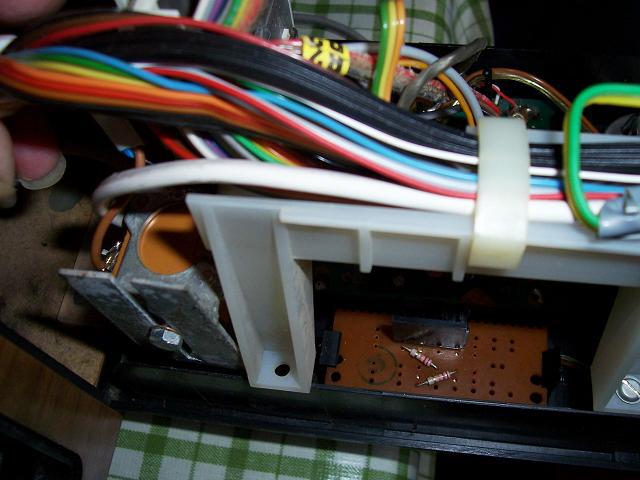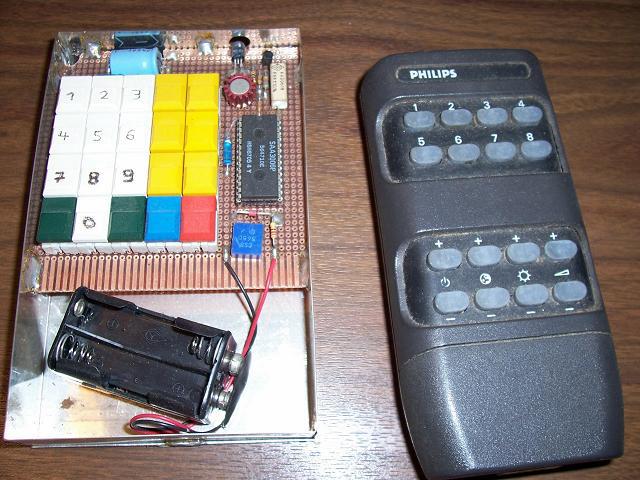
------------------------------------- | Watching TV can be fun... | | even when doing it from the inside. | -------------------------------------

Many years ago, elektronics hobbyists did like to play
with the K9 chassis, because it was nice and service
friendly, and every TV came together with a neat,
colored set of schematics.
At some point, people did start to throw away their
old TVs, and I did salvage plenty of spare parts
from scrap, for being able to repair my old TV at home.
As the mains switch went defective, I started to
wonder if it would be possible to replace it by a
more reliable solution.
First, I did replace the switch with a "pushbutton"
like those used in control cabinets...

(The brown thing at the left side of the picture.)
It triggered an "Eltako", as used in staircase
illuminations, which turned on/off a neat contactor
(at the right side of the picture).

Note the PCB material below the contactor:
A homebuilt "silencer" to prevent the casing of
the TV from humming at 50 Hz.
Two switches 16A were wired in parallel, to make
the contactor live longer than than the rest of the TV.
Unfortunately the TV did have sensor buttons to change
the cannels, things that sense the impedance of the
tip of your finger... and after two decades of operation,
cleaning solvent didn't help anymore to keep them
working.
Also, the Nixie tube in the display did fail to show
all of the numbers, so I did decide to build something
more reliable.


Middle: precision DIP socket, holding a 7 segment display.
Right: receiver for an IR remote control...
The ICs related to said sensors also did show some
signs of oxidation/corrosion, so I just did replace that
part of the circuitry with some CMOS logic ICs from
the drawer.
Some Schmitt triggers, a priority encoder, a latch,
then a decoder and some transistors to drive the reed
relays (not shown in this picture), which sent different
voltages to the tuner.

Did have no 7 segment decoder/driver IC in the drawer,
so I did use a handful 1N4148 diodes instead.
Now for the next modification:
The ultrasonic remote control of the TV went
defective, maybe because of leaking battery acid...
Buying a replacement for the remote control did turn
out to be very expensive, so I did decide to build my
very own IR remote control.
Ok, so it won't win a price for beauty, on the other
hand it won't be impressed when getting thrown at a
brick wall.

Some years later, I did find an original ultrasonic
remote control in the dumpster, so it was possible
to control the TV by IR and ultrasonic at the same
time...
Problem was, the TV did have no microcontroller at all,
and for some reasons I wanted to keep it that way.

Right side: original Philips ultrasonic control
circuitry. The metal box did have a sign on it:
"If the TV happens to do anything strange, replace
the whole box with another box from the factory.
Thou shalt not try to repair it by yourself."
As a hobbyist, you can't resist such labels.

Figured out, that they did use 74xx up/down counters
with DACs built from simple resistor networks to set
volume, brightness and such.
And I happen to know, what to do with 74xx ICs...
Now to take a look into my IR decoder:

Basically a SAA3009, connected to some decoders,
which did drive 74LS06 ICs, connected to the wires
which tapped into the original ultrasonic control
circuitry.
Don't try such things at home, kids.
(If I wouldn't have had some SAA3006/SAA3009 ICs
in the drawer, I would have tried something different,
just don't ask...)
At some point, I did want to have a standby
mode, so I did a few more modifications.

Here the switchmode power supply, with a cable
which wasn't intended to be there by the manufacturer.

And a transformer with a 9V output, which powered
the control circuitry during standby.

But in the end, it did feel too much like riding a
dead horse.
As it went defective again, I didn't want to fix it
anymore, so the TV went scrapped back in 2007.
I somehow doubt, that you have a chance to keep
nowadays modern TVs up and running for more than
30 years as a mere electronics hobbyist...
After the K9 went out of production, Philips did
build a chassis which somehow did look like
engineered by evil space aliens.
Well, I still happen to have a Grundig TV
from 1988, but that's another story.
I only had to repair it two times... yet.
(c) Dieter Mueller 2008